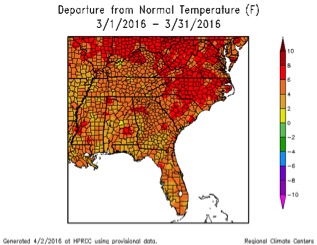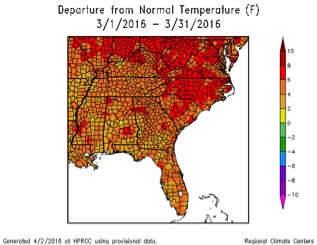March was drier and warmer than normal across Georgia, ushering in projections for a warmer and wetter than normal spring.
Warm conditions statewide caused early blooming of many trees and flowers, leading to very high pollen counts, which were not helped by the lack of rain needed to wash away the pollen. Early blooming in the northeastern part of the state led the National Weather Service to start issuing frost warnings there earlier than usual because of farmers’ concerns about the fruit trees. In spite of the cold weather in late March, most fruit trees across Georgia were not affected by frost, and a good and flavorful peach crop is expected this year unless a very late frost occurs in April.
The lack of rainfall caused abnormally dry conditions across the state. This allowed farmers to get into the fields to plant and apply chemical, but dry conditions caused some concerns for germinating crops.
Wet conditions in the southwest corner of the state hampered farmers’ ability to work in the fields and led to the development of some fungal diseases by the end of the month.
The outlook for April does show colder temperatures in the beginning of the month, but a return to warmer conditions later. Precipitation is expected to be above normal for the first half of the month, but drier conditions may return in the last two weeks.
Warmer March
Georgia saw well above normal temperatures in March, ranging from 3 to 6 degrees above the 1981-2010 average.
In Atlanta, Georgia, the monthly average temperature was 60.5 degrees Fahrenheit, 6.2 degrees above normal; the Athens, Georgia, average was 59.9 F, 5.6 degrees above normal; the Columbus, Georgia, average was 61.9 F, 4.1 degrees above normal; the Macon, Georgia average was 61.1 F, 4.3 degrees above normal; the Savannah, Georgia, average was 65.0 F, 5.8 degrees above normal; the Brunswick, Georgia, average was 64.9 F, 4.6 degrees above normal; the Alma, Georgia, average was 63.6 F, 3.4 degrees above normal; the Augusta, Georgia, average was 60.8 F, 4.9 degrees above normal; the Albany, Georgia, average was 63.7 F, 4.5 degrees above normal; the Rome, Georgia, average was 56.8 F, 4.7 degrees above above normal; and the Valdosta, Georgia, average was 64.7 F, 4.6 degrees above normal.
Multiple records for daytime high temperatures were set on March 15 across the state. Atlanta reported 85 F; Athens, 86 F; Alma, 87 F; and Columbus, 87 F, breaking the old records of 82 F, 85 F, 86 F and 86 F, respectively, all set in 2012.
Macon also tied its record of 87 F on the same day, and Augusta, Savannah and Brunswick tied records on or near that date. Brunswick also broke a record high on March 14, recording 84 F, which surpassed the old record of 83 F set in 1975.
Precipitation
The highest monthly total precipitation recorded by the National Weather Service was 6.17 inches in Valdosta, 1.30 inches above normal, and the lowest was recorded in Brunswick at 1.56 inches, 2.32 inches below normal. Atlanta received 2.21 inches, 2.60 below normal; Athens received 1.95 inches, 2.48 inches below normal; Columbus received 2.56 inches, 2.90 inches below normal; Macon received 2.64 inches, 1.91 inches below normal; Savannah received 5.01 inches, 1.28 inches above normal; Augusta received 3.18 inches, 1.00 inch below normal; Alma received 2.87 inches, 1.88 inches below normal; Albany received 4.77 inches, 0.28 inches below normal; and Rome received 4.86 inches, 0.09 inches below normal.
Savannah set a daily precipitation record on March 27 when 3.98 inches fell at the airport, far surpassing the old record of 2.57 inches for that date set in 2005.
The highest single-day rainfall recorded by Community Collaborative Rain, Hail and Snow Network (CoCoRaHS) volunteers was 4.57 inches, measured one mile north of Pooler, Georgia, in Chatham County on March 28, followed by two other Pooler observers who measured 4.25 and 3.98 inches on the same date.
The highest monthly rainfall recorded by CoCoRaHS volunteers was 7.89 inches, measured south of Donalsonville in Seminole County. This repot was followed by 7.25 inches in Thomasville in Thomas County and 7.09 inches measured in Bainbridge in Grady County.
CoCoRaHS volunteers also recorded 2.0 inches of snow near Dillard in Rabun County and Nelson in Pickens County on March 4. This was the only day of the month with snow, so these are also the monthly totals.
Severe weather was observed on five days in March. The most notable was a brief tornado touchdown eight miles west of Pelham in Grady County on March 31. The tornado caused some damage to trees and powerlines.
For more information on Georgia weather conditions, see the “Climate and Agriculture” blog at blog.extension.uga.edu/climate/ or visit at www.gaclimate.org. Email weather and climate impacts on agriculture to share to pknox@uga.edu.








